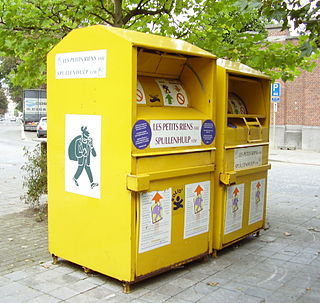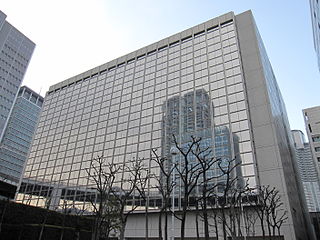Related Research Articles

Nylon is a family of synthetic polymers with amide backbones, usually linking aliphatic or semi-aromatic groups.

Wool is the textile fiber obtained from sheep and other mammals, especially goats, rabbits, and camelids. The term may also refer to inorganic materials, such as mineral wool and glass wool, that have some properties similar to animal wool.

Textile is an umbrella term that includes various fiber-based materials, including fibers, yarns, filaments, threads, different fabric types, etc. At first, the word "textiles" only referred to woven fabrics. However, weaving is not the only manufacturing method, and many other methods were later developed to form textile structures based on their intended use. Knitting and non-woven are other popular types of fabric manufacturing. In the contemporary world, textiles satisfy the material needs for versatile applications, from simple daily clothing to bulletproof jackets, spacesuits, and doctor's gowns.

Dyeing is the application of dyes or pigments on textile materials such as fibers, yarns, and fabrics with the goal of achieving color with desired color fastness. Dyeing is normally done in a special solution containing dyes and particular chemical material. Dye molecules are fixed to the fiber by absorption, diffusion, or bonding with temperature and time being key controlling factors. The bond between the dye molecule and fiber may be strong or weak, depending on the dye used. Dyeing and printing are different applications; in printing, color is applied to a localized area with desired patterns. In dyeing, it is applied to the entire textile.

Cordura is a collection of synthetic fiber-based fabric technologies used in a wide array of products including luggage, backpacks, trousers, military wear and performance apparel.

Fast fashion is the business model of replicating recent catwalk trends and high-fashion designs, mass-producing them at a low cost, and bringing them to retail quickly while demand is at its highest. The term fast fashion is also used generically to describe the products of this business model, particularly clothing and footwear. Retailers who employ the fast fashion strategy include Primark, H&M, Shein, and Zara, all of which have become large multinationals by driving high turnover of inexpensive seasonal and trendy clothing that appeals to fashion-conscious consumers.

"Technical textile" refers to a category of textiles specifically engineered and manufactured to serve functional purposes beyond traditional apparel and home furnishing applications. These textiles are designed with specific performance characteristics and properties, making them suitable for various industrial, medical, automotive, aerospace, and other technical applications. Unlike conventional textiles used for clothing or decoration, technical textiles are optimized to offer qualities such as strength, durability, flame resistance, chemical resistance, moisture management, and other specialized functionalities to meet the specific needs of diverse industries and sectors.

Textile recycling is the process of recovering fiber, yarn, or fabric and reprocessing the material into new, useful products. Textile waste is split into pre-consumer and post-consumer waste and is sorted into five different categories derived from a pyramid model. Textiles can be either reused or mechanically/chemically recycled.

Sustainable fashion is a term describing efforts within the fashion industry to reduce its environmental impacts, protect workers producing garments, and uphold animal welfare. Sustainability in fashion encompasses a wide range of factors, including cutting CO2 emissions, addressing overproduction, reducing pollution and waste, supporting biodiversity, and ensuring that garment workers are paid a fair wage and have safe working conditions.

Electronic textiles or e-textiles are fabrics that enable electronic components such as batteries, lights, sensors, and microcontrollers to be embedded in them. Many smart clothing, wearable technology, and wearable computing projects involve the use of e-textiles.

Clothing technology describes advances in production methods, material developments, and the incorporation of smart technologies into textiles and clothes. The clothing industry has expanded throughout time, reflecting advances not just in apparel manufacturing and distribution, but also in textile functionality and environmental effect. The timeline of clothing and textiles technology includes major changes in the manufacture and distribution of clothing.

Toyobo Co., Ltd. is one of Japan's top makers of fibers and textiles, including synthetic fibers and natural fibers, such as cotton and wool.
NILIT Ltd. is a privately owned, international manufacturer of nylon 6.6 (polyamide) fibers headquartered in Migdal HaEmek, Israel. NILIT specializes in the polymerization, spinning and texturing of nylon 6.6 yarns for textile applications.
Zero-waste fashion refers to a fashion design strategy that generates little or no textile waste during the production process, particularly focusing on the pattern making and cutting stages. It is a reaction to the high amount of discarded clothing items going into landfill around the world.
Fashion forecasting began in France during the reign of Louis XIV. It started as a way of communicating about fashion and slowly transformed into a way to become ahead of the times in the fashion industry. Fashion forecasting predicts the moods of society and consumers, along with their behavior and buying habits and bases what they may release in the coming future off of the forecast. Fashion trends tend to repeat themselves every 20 years, and fashion forecasting predicts what other trends might begin with the rotation of fashion as well. Fashion forecasting can be used for many different reasons, the main reason being staying on top of current trends and knowing what your consumer is going to want in the future. This method helps fashion brands know what to expect and what to begin producing ahead of time. Top name brands and high end companies such as Vogue and Gucci even use this method to help their designers become even more informed on what is to come in the fashion industry.
Wet Processing Engineering is one of the major streams in Textile Engineering or Textile manufacturing which refers to the engineering of textile chemical processes and associated applied science. The other three streams in textile engineering are yarn engineering, fabric engineering, and apparel engineering. The processes of this stream are involved or carried out in an aqueous stage. Hence, it is called a wet process which usually covers pre-treatment, dyeing, printing, and finishing.
The textile industry is the largest manufacturing industry in Pakistan and nearly 25 million people work in this industry. Pakistan is the eighth largest exporter of textile commodities in Asia. Textile sector contributes 8.5% to the GDP of Pakistan.

Maria Bogner was a German fashion designer credited with developing practical stretch pants, thereby profoundly affecting the direction of the ski fashion industry. She created colorful, sexy, and functional stretchy skiwear. Her husband's established ski apparel company, the development of stretch material in the 1950s, and her sewing skills all contributed to her success. Her stretch pants, as modeled by leading ski athletes of the period, provided aerodynamic, form-fitting cut, color variety and practicality as ski garments.

Textile performance, also known as fitness for purpose, is a textile's capacity to withstand various conditions, environments, and hazards, qualifying it for particular uses. The performance of textile products influences their appearance, comfort, durability, and protection. Different textile applications require a different set of performance parameters. As a result, the specifications determine the level of performance of a textile product. Textile testing certifies the product's conformity to buying specification. It describes product manufactured for non-aesthetic purposes, where fitness for purpose is the primary criterion. Engineering of high-performance fabrics presents a unique set of challenges.
Recover Textile Systems, mainly known as Recover™, is a materials science company and producer of mechanically recycled cotton fiber and recycled cotton fiber blends, created in 2020 with its headquarters in Banyeres de Mariola, Spain.
References
- 1 2 3 4 5 6 7 8 Kadolph, Sara J. (1998). Textiles. Upper Saddle River, N.J.: Merrill. ISBN 978-0-13-494592-7.
- ↑ Cresswell, Lesley (2002). Textiles at the cutting edge. London: Forbes Publications. pp. 6, 7, 8. ISBN 978-1-899527-17-5.
- 1 2 Horne, L. (2011-11-24). New Product Development in Textiles: Innovation and Production. Elsevier. p. 3. ISBN 978-0-85709-519-0.
- ↑ Gebremikael, Mebrahtom. "New Product Development and Its Applications in Textiles Article in Journal of Textile and Apparel, Technology and Management · June 2005 4 PUBLICATIONS 40 CITATIONS SEE PROFILE New Product Development and Its Applications in Textiles".
{{cite journal}}: Cite journal requires|journal=(help) - ↑ S. O. Priya | A. Vishal. A Study on Supply Chain Management in Textiles Industry.
- ↑ Gale, Colin (2004). Fashion and textiles : an overview. Oxford, UK; New York: Berg. pp. 13, 16. ISBN 978-1-4237-4714-7.
- ↑ Schön, Donald A. (1967). Technology and change; the new Heraclitus. New York: Delacorte Press. pp. 220–230.
- ↑ Fairchild's dictionary of textiles. New York: Fairchild Publications. 1959. p. 475.